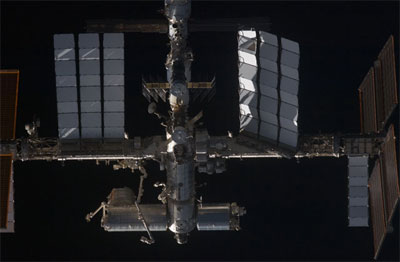A solution to the space station’s long-term futureby Edward Ellegood
|
| Can the agency send humans beyond low Earth orbit while sustaining other multi-billion dollar programs that do not? The answer should be yes, but economic realities may force the agency to chronically underfund and underutilize the ISS. |
NASA’s proposed budget for ISS will average about $2.5 billion per year through 2016, after which any number of things might happen. Post-2016 options range from de-orbiting the outpost to detaching some modules so Russia and Europe can develop an orbiting “shipyard” for assembling Moon/Mars exploration vehicles. After negotiations this summer, NASA and its 14 international partners will likely agree to continue operating the ISS beyond 2016 as a US-led program.
Although it receives less from NASA than the $3 billion currently devoted annually to the Space Shuttle, the ISS represents a similar budgetary and policy conundrum: can the agency send humans beyond low Earth orbit while sustaining other multi-billion dollar programs that do not? The answer should be yes, but economic realities may force the agency to chronically underfund and underutilize the ISS. Before we reach that point, NASA should take a fresh look at a decade-old concept for “outsourcing” ISS operations.
NASA in 2000 began the process for selecting a non-governmental organization (NGO) to take responsibility for ISS “utilization development and management,” only to cancel the effort about a month before proposals were due. One model for this NGO approach was the Space Telescope Science Institute, the multi-university group that manages utilization of the Hubble Space Telescope.
This kind of outsourcing may now seem unlikely since Congress in 2005 designated the US portions of ISS as a “National Laboratory,” but the opposite is true. A quick review of national labs sponsored by US Department of Energy (DOE) reveals that most of them are managed or operated by NGOs that are either led by, or partnered with, universities or consortia of universities. These DOE labs are widely viewed as the family jewels of US scientific endeavor, and their missions are a hand-in-glove fit with the goals of our nation’s research universities.
| Despite its shortcomings thus far as a research platform, the lessons learned from the first decade of ISS crewed operations are prerequisites to NASA’s broader exploration goals. |
As our newest national laboratory, the ISS deserves a similar NGO relationship. There’s no guarantee that the NGO approach alone will reduce ISS costs, but if structured properly it might be NASA’s best shot at reducing their budget burden while maximizing ISS science payback for the nation. As demonstrated at other national laboratories, the NGO approach can incentivize and facilitate research participation by the private sector and universities, while accommodating cost sharing with other federal agencies. In addition, by working with emerging commercial providers like SpaceX and Orbital Sciences for ISS cargo and crew transport, an NGO could also provide ISS access for fare-paying commercial visitors.
Management approaches aside, let’s not forget that the ISS has been, and should continue to be, an invaluable testbed for deep-space exploration. The experience we’ve gained with hardware engineering, life support systems development, human factors, and other science in the vacuum and microgravity environment of space could never have been duplicated on Earth. Despite its shortcomings thus far as a research platform, the lessons learned from the first decade of ISS crewed operations are prerequisites to NASA’s broader exploration goals.
Let’s implement an NGO management approach to the ISS National Laboratory, so its second decade can complement NASA’s exploration efforts without diverting the agency’s focus from the Moon, Mars and beyond.
